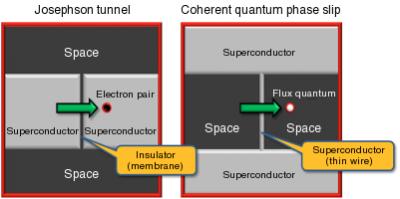A team of researchers from the NEC Smart Energy Research Laboratories and RIKEN Advanced Science Institute has experimentally demonstrated the existence of a subtle phenomenon known as coherent quantum phase slip (CQPS) for the first time using ‘phase-slip qubit,’ a new kind of qubit developed by the team.
 This figure shows the Josephson tunnel (left) and coherent quantum phase slip (right). At left, two superconductors are separated by thin insulator (in this case space). A current is produced by superconducting electron pairs tunneling across the insulator. At right, two insulators are separated by superconductor. A current is produced by magnetic flux tunneling across the superconductor. (Credit: RIKEN)
This figure shows the Josephson tunnel (left) and coherent quantum phase slip (right). At left, two superconductors are separated by thin insulator (in this case space). A current is produced by superconducting electron pairs tunneling across the insulator. At right, two insulators are separated by superconductor. A current is produced by magnetic flux tunneling across the superconductor. (Credit: RIKEN)
The breakthrough findings provide new insights into the subtle phenomenon, an innate result of the superconductivity theory. The existence of the phenomenon has long been hypothesized but never experimentally demonstrated before. The study results have been reported in the journal, Nature.
Josephson junction is one of the key applications of superconductivity. This junction is based on the Josephson effect that describes the tunneling of a superconducting current between superconductors, isolated by a thin insulating layer. In Josephson junction, a thin insulator separates two superconductors, whereas in CQPS, a superconductor separates two insulators.
The research team demonstrated CQPS in a thin superconducting indium oxide wire. By inserting the thin wire into a large superconducting loop, the research team formed the phase-slip qubit, a new quantum device where the narrow wire (superconducting layer) was placed between insulating layers of vacant space. By monitoring microwave frequencies and altering the magnetic flux piercing the superconducting loop, the team was able to discover an energy band gap between the system’s two flux states, as explained by the theory.
Quantum mechanics causes this energy gap by forcing the two states to tunnel across the thin wire and via a quantum phase-slip in the superconducting layer, thus preventing them from achieving the same energy level. Besides experimentally demonstrating the existence of CQPS, the study also leads to the development of a new kind of devices that harness quantum phase-slip’s unique functionality, opening up new opportunities in superconducting electronics.